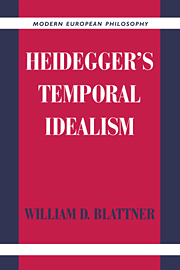Book contents
- Frontmatter
- Contents
- Acknowledgments
- A Note on Sources
- Introduction. Ontology, Phenomenology, and Temporality
- 1 Care as the Being of Dasein
- 2 Originary Temporality
- 3 World-Time and Time-Reckoning
- 4 The Ordinary Conception of Time and Disengaged
- 5 Heidegger's Temporal Idealism
- Conclusion. The Consequences of the Failure of Heidegger's Temporal Idealism
- Bibliography
- Index
Introduction. Ontology, Phenomenology, and Temporality
Published online by Cambridge University Press: 05 June 2012
- Frontmatter
- Contents
- Acknowledgments
- A Note on Sources
- Introduction. Ontology, Phenomenology, and Temporality
- 1 Care as the Being of Dasein
- 2 Originary Temporality
- 3 World-Time and Time-Reckoning
- 4 The Ordinary Conception of Time and Disengaged
- 5 Heidegger's Temporal Idealism
- Conclusion. The Consequences of the Failure of Heidegger's Temporal Idealism
- Bibliography
- Index
Summary
The official project of Martin Heidegger's Being and Time is an abstract inquiry into the sense (Sinn, more colloquially, the meaning) of “being,” even though it has become famous primarily for its analysis of the nature of human existence. Heidegger launches his project on the first page of the treatise byway of a quote from Plato's Sophist (244a), which he translates thus:
“Then manifestly you are long since familiar with what you actually mean, when you use the expression ‘be-ing’; we, however, once thought we understood it, but have now become embarrassed.”
(S&Z, p. 1)He continues in his own voice:
Do we have today an answer to the question concerning what we actually mean by the word “be-ing?” In no way. And so, it is our task to raise anew the question concerning the sense of being. Are we then also merely in the embarrassing situation of not understanding the expression “being?” In no way. And so, it is our task first of all to awaken once again an understanding of the sense of this question. The concrete elaboration of the question concerning the sense of “being” is the intent of the following treatise. The Interpretation of time as the possible horizon of any understanding of being at all is its preliminary goal, (ibid.)
Being and Time intends to develop an account of the sense of “being” by linking being with time; time is to be the “horizon” of “any understanding of being at all.”
- Type
- Chapter
- Information
- Heidegger's Temporal Idealism , pp. 1 - 30Publisher: Cambridge University PressPrint publication year: 1999



